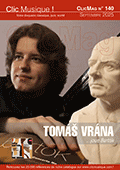 Découvrir des compositeurs, une école de facture d’orgues et un interprète, tous méconnus chez nous, aurait pu susciter l’intérêt. Hélas ! on déchante vite : L’instrument d’Husby, qu’on nous dit pourtant « du XVIII° s. », et « splendide pour une église de campagne » est en fait d’une sonorité éteinte et sombre (on croirait entendre un orgue Mutin de 1910). Les pièces qu’on nous présente comme « musiques pour clavier de l’école suédoise du XVIII° s. » ne sont pour la plupart que des transcriptions dont le bien-fondé est loin d’être évident. Certaines pièces laissent pantois : l’une d’elles, lente, à deux voix, ne dure que… 18 secondes ! L’organiste joue tout cela gravement. Même les Variations sur Ah, vous dirais-je, Maman de l’abbé Vogler, allemand émigré en Suède, célèbre pour ses improvisations pittoresques, manquent ici totalement d’humour ! La Suède possède sûrement des instruments, un répertoire de qualité et des organistes « historiquement informés » (comme dans tous les pays d’Europe). Encore eût-il fallu opérer des choix plus heureux. (Jean-Paul Lécot)  This recording is a modern portrait of the music that Swedish clavier-players might have carried to the organ in the latter half of the 1700s. Since hardly any Swedish music of the time was written exclusively for the organ, we must rely on historical sources for a sense of the possibilities. The selection offered here is largely a work of reconstruction, and except for the short movement by Roman, none of this repertoire has been recorded before, at least in this form for organ. Jonas Lundblad is an organist and musicologist. He studied church music in Malmö, Lübeck and Pitea, specializing in organ interpretation. A prolific freelance career performing both as an organ soloist and with choirs and orchestras has taken him to countries across Europe. When choosing repertoire, he looks mainly to the Romantic era and to new music and enjoys delving into the sources to discover unknown or forgotten works. While a student for Hans-Ola Ericsson, he performed the complete works of Olivier Messiaen. Since then, the music and mental landscape of Messiaen have remained one his central influences. As a researcher at the Department of Musicology at Uppsala University, Lundblad engages with historical musical aesthetics in a variety of ways, exploring connections to both philosophy and theology. A particular interest is German Romanticism, especially the aesthetics of Friedrich Schleiermacher. The Organ at Dala-Husby is Sweden’s second-largest preserved eighteenth-century organ, next after the famous Cahman organ at Leufsta Bruk. Completed in 1783, it was built by the church’s own organist, Nicolas Söderström (1730–1810). A former apprentice to the prominent organ builders Gren & Strahle in Stockholm, Söderström had received a royal privilege to build his own instruments. Perhaps his personal investment in the project explains why the Husby organ is so unusually splendid for a country church. The organ was retired from service in 1936, but was preserved and could be restored and returned to service in 2011. Söderström’s technical solutions were occasionally idiosyncratic, something that affects the touch of the keyboard as well as the wind system and the timbre of the pipes. Yet the combination of a classic plenum, distinctive reed stops, and empfindsam, pre-Romantic solo stops also make the Dala-Husby organ one of the most important organs of Sweden’s Gustavian age. Moreover, the lack of an independent pedal division makes it an idea organ for recreating the practice of the clavierplayers: complementing music written for the hands with the flexible use of the feet.
 |
